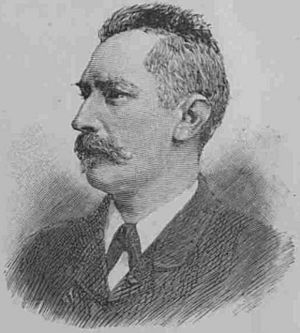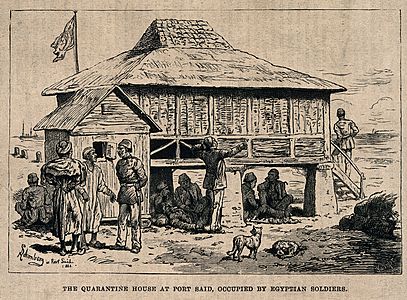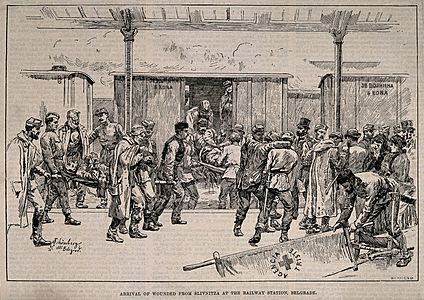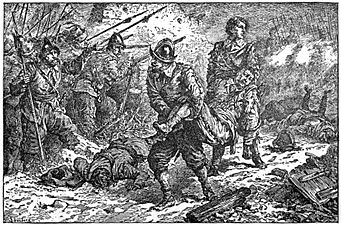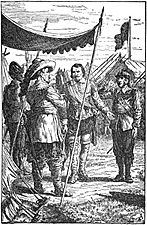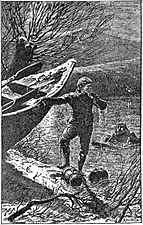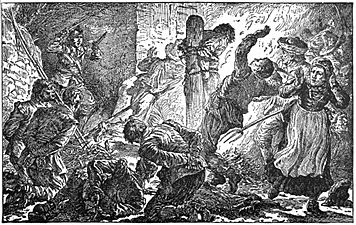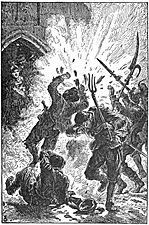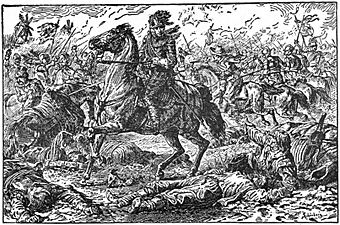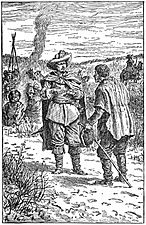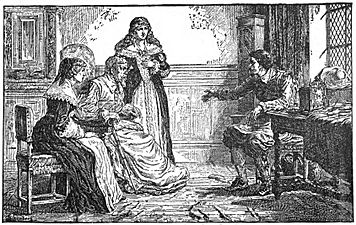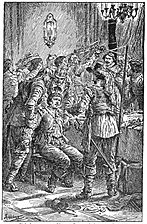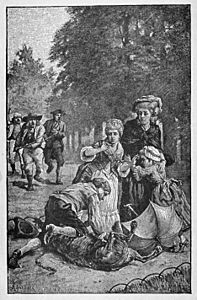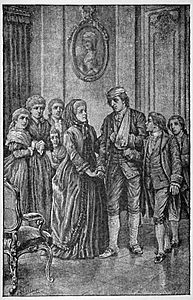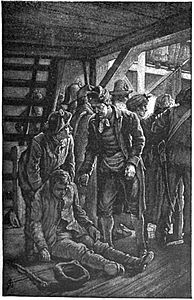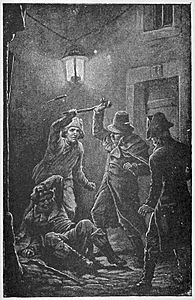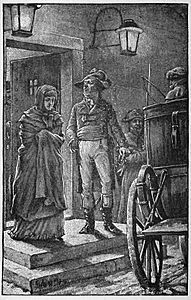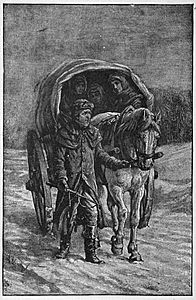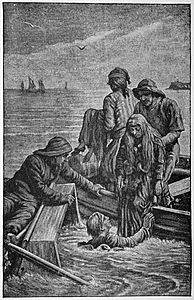Johann Schönberg facts for kids
Johann Nepomuk Schönberg (1844–1913) was an amazing Austrian artist. He was also a war correspondent, which means he reported from war zones. He drew pictures of many wars and big events during his life. He was known for his detailed illustrations that showed what was happening in the world.
Early Life and Art Training
Growing Up and Learning Art
Johann Schönberg came from a family of artists. His father, Adolf, and his grandfather, Johan, were both famous engravers. An engraver is someone who carves designs onto metal plates to make prints.
Johann studied art at the Academy of Fine Arts Vienna from 1858 to 1860. Later, he went to Munich to learn from Hermann Anschütz. But he had to stop his studies to help his father, who was struggling financially.
Early Art Projects and Military Service
A famous artist named Fritz L'allemand saw some of Johann's smaller war paintings. He asked Johann to help him finish a large painting. Johann worked on this for several months.
Schönberg also served as a soldier in the Austrian army. He fought in the Battle of Custoza (1866) and the Austro-Prussian War in 1866. He sent sketches from these wars to the Illustrated London News newspaper.
Joining Art Societies and Moving to England
Between his military duties, he continued his art studies in Vienna and Munich. He became a member of the Vienna Artists' Society. Around 1873, he married Pauline. They did not have any children. Soon after their marriage, they both moved to England.
Schönberg's Artistic Career
Creating Many Artworks
Johann Schönberg created a huge number of artworks during his life. He made more than 2,000 drawings and paintings. Most of his paintings were done because someone asked him to, rather than him just painting what he wanted. He almost never showed his art in exhibitions.
People thought Schönberg's sketches were very well drawn. They showed scenes exactly as they happened. When he drew many people, he was good at arranging them. Some people wished he would create more big art pieces instead of just illustrations.
Paintings for Prince Carol of Romania
One special project Schönberg worked on was for Prince Carol of Romania. Romania had just become an independent country. The Prince asked Schönberg to paint six important events from the Romanian War of Independence.
Schönberg had seen these events himself. He used his own sketches and drawings from the war. He worked hard to make sure everyone in the paintings looked accurate. This big project took him 25 years to finish!
- The Crossing of the Danube
- The Bombardment of Vidin (also called This is the music I like!)
- The Assault on the Grivitza Redoubt
- The Ruling Prince visiting the Grivitza Redoubt
- Prince Carol at the Battle of Plevna
- The first Meeting between Prince Carol I and Osman Nuri Pasha after the Surrender
Illustrations for Newspapers and Magazines
Schönberg drew pictures for many newspapers and magazines. He started in Austria, then worked for publications in Germany, France, and England.
Some of the papers he illustrated for were:
- Über Land und Meer (Stuttgart)
- Illustrirte Zeitung (Leipzig)
- Daheim (magazine)
- Illustrierte Welt
- Le Monde Illustré
- Illustrated London News (He worked for them from 1866 for over 20 years)
- The Sphere
Schönberg didn't just do his own drawings. He also helped finish drawings sent in by other artists. For weekly illustrated papers, drawings were first made, then carved onto plates for printing. He even worked on drawings by Melton Prior from the Zulu War in 1879. His drawing style often used thick paint with grey washes.
Illustrating Wars and Disasters
Schönberg was a correspondent and an artist. He sent reports and did interviews, along with his sketches. He covered many conflicts and disasters.
Examples of Illustrations from War Zones
These illustrations were drawn or painted by Schönberg during different military campaigns. They show examples of medical care during wartime.
-
The Quarantine House for Egyptian soldiers suffering from the plague at Port Said during the British Conquest of Egypt (1882)
-
Wounded Chinese prisoners getting medical treatment at Pyongyang, Korea, during the first Sino-Japanese War (1894–1895)
Conflicts and Events Covered by Schönberg
- The American Civil War (1861–1865): His first experience drawing military scenes was in 1863.
- The Third Italian War of Independence (1866): He was a soldier and an illustrator.
- The Austro-Prussian War (1866): This was his first work for the Illustrated London News.
- The Franco-Prussian War (1870–1871)
- The Serbo-Turkish War (1876–1877): He covered the tensions in Bulgaria for the Illustrated London News.
- Russo-Turkish War (1877–1878): He was the Special Artist for the Illustrated London News.
- The flooding of Szegedin, Hungary, in 1879: This disaster destroyed most of the houses.
- The British Conquest of Egypt (1882) (1882)
- The Serbo-Bulgarian War (1885)
- The cholera epidemic in Hamburg in 1892: Over 8,000 people died.
- The First Sino-Japanese War (1894–1895)
- The Second Boer War (1899–1902): He traveled to South Africa to cover the war from the Boer side. He made many sketches and was even slightly wounded.
- The Boxer rebellion (1899–1901): He was one of only ten war correspondents to receive the China War Medal for this campaign.
Illustrations for Books
Schönberg also illustrated many books, especially children's fiction. He drew pictures for non-fiction books too, like a history of the Popes.
Some of the authors whose books he illustrated were:
- Elbridge Streeter Brooks: A writer of stories and non-fiction for children.
- Harry Collingwood: Wrote adventure stories for boys, often about the sea.
- Edward S. Ellis: A well-known American adventure writer.
- George Manville Fenn: Wrote mostly for young adults.
- Henry Frith: An Irish author who translated many of Jules Verne's novels.
- John Percy Groves: A soldier who wrote exciting stories for boys.
- G. A. Henty: A very productive writer of adventure stories for boys, often set in history.
- Georgina Norway: Wrote adventure stories for children.
Examples of Book Illustrations
Schönberg illustrated The Lion of the North, a story by G. A. Henty. This book was about the times of Gustavus Adolphus and the wars of religion. Schönberg created twelve full-page illustrations for it.
He also illustrated another Henty story called In the Reign of Terror. This book was about the French Revolution. Schönberg made eight full-page drawings for this book.
Later Life and Death
Johann Schönberg passed away on December 2, 1913, in Beckenham, London. He was buried in Lambeth North Cemetery a few days later. His wife, Pauline, managed his estate after he died.


